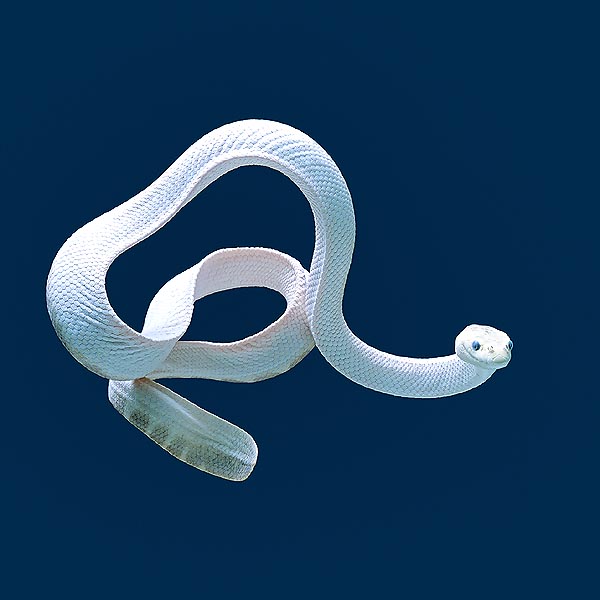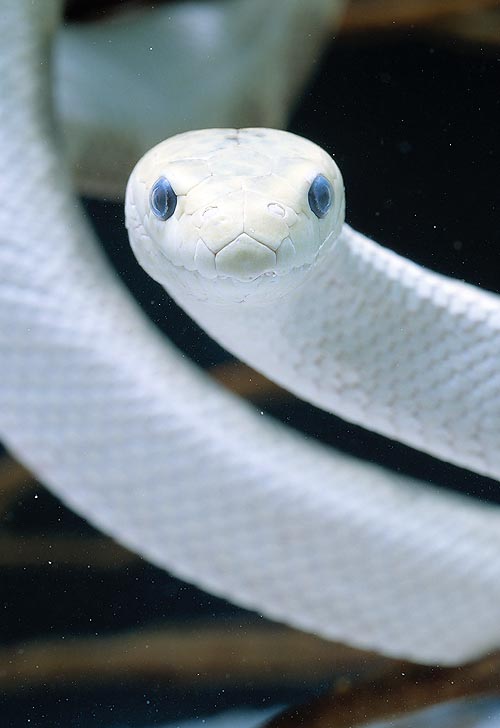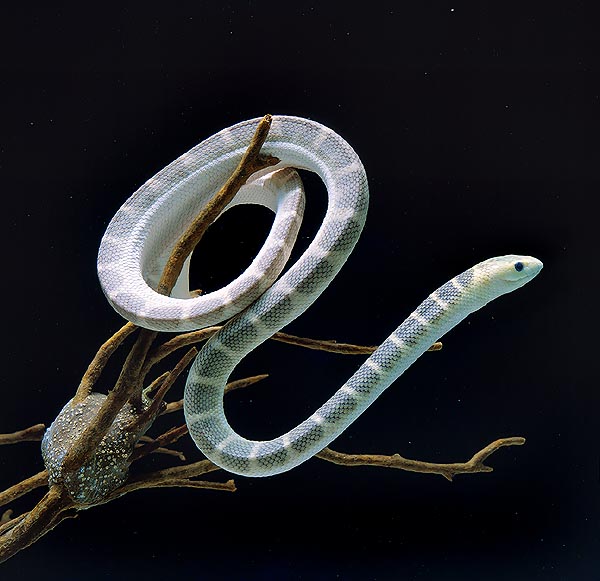Family : Hydrophiidae

Text © Dr. Gianni Olivo

English translation by Mario Beltramini

Hydrophis elegans has one lung only, but breathes also through the skin © Giuseppe Mazza
From a general point of view, excluding the non-poisonous sea snakes belonging to other families (for instance that of the Colubrids, which includes the Homalopsinae and a member of the Natricinae, and the family of the Acrochordidae) the sea snakes are united in two families: that of the Hydrophiidae, that is the one of the true marine serpents and that of the Laticaudidae, called sea bungarus or “sea kraits”. We shall treat here only about one species belonging to the Hydrophiidae: the Elegant sea snake (Hydrophis elegans).
This reptilian has a vast geographic diffusion: from the northern, western and eastern coasts of Australia, it goes, eastward, up to good part of the islands and archipelagos of Pacific, northward, up to the coasts of the south-eastern Asia, through Indonesia and, westward, yup to the Sri Lanka. It loves deep and troubled waters with muddy or sandy bottom, where it hunts mostly eels and small morays, better, the conformation of the wedge-shaped body, as we shall see later on, with the fore part more pointed and the back part bigger, helps is in entering the holes where these fishes do take shelter.
This specialized diet is typical of the hydrophiids equipped with rather narrow mouth, which would hinder the ingestion of voluminous fishes. It is a serpent which may reach big dimensions, up to 220 cm of length, even if the average, for the adults, stands around the 180 cm, with transversally flattened tails, with the shape of a paddle or of an oar, which is an extremely effective swimming body. The body is slender, but, oddly, tends to get bigger in the back part.
One of the English names, bar-bellied sea snake refers mainly to the young specimens which have evident and marked bands, whilst in the adult these bands fade, reducing at times, to a series of small dots in the vertebral region or even, in some cases, may completely disappear.
However, quite often, the bands remain visible also in the adult, even if they tend to be little contrasted. The background colour is variable, going from the brown to the dark brown and to the olive-green, up to the pale grey, and there are specimens which seem even white. The ventral part is pale or white, but the lower part of the neck which may be dark or even black. The head may be of the same colour as the body or differ slightly, with shades of grey or green-grey, but it may also be very dark.
The sexual dimorphism practically does not exist, with almost identical colouration for both sexes: the only difference, apart the reproductive system, stands in a greater average length of the female. The scales, by mid body, are placed in 35-45 rows and the ventral ones, unlike most of the terrestrial serpents, have the same dimensions of the remainder of the body or, at the most, are only slightly bigger. The scales covering the head are fairly big and smooth and, in the adults, the pre-ocular and the post-ocular ones have some small protrusions.
The venom fangs are rather short, from 2,5 to 3 mm as an average, even if there are reports of lengths of 3,9 mm. For what the dangerousness of the sea snakes in general, there are many claptraps and incorrect beliefs among the general public.

The bite of Hydrophis elegans may be fatal for man © Giuseppe Mazza
It is true, as an average, that the venomous sea snakes have very powerful venoms, but it is also true that most of them may inoculate, with a bite, much more reduced quantities than those of many mainland serpents. But also here there are the due exceptions and therefore I make a digression for explaining what I mean. Many sea snakes are almost harmless, as because extremely reluctant to bite (for instance, Pelamis platurus and Laticauda laticaudata) and because of the high incidence of “dry bites”, or, also, because of the modest dosages of venom they secrete, but, to the other extreme, there are highly dangerous species and among these, I mention especially Enhydrina schistosa, responsible of the 90% of the lethal cases of sea snake bite, which may inoculate even 80 mg of venom, enough to kill, theoretically, more than 50 adult persons, and which has an aggressive temper and is ready to bite.
For what the Hydrophis elegans is concerned, the quantity of venom inoculated with the bite or obtained by milking is modest, an average of 7 mg: it is a venom with a power similar to that of the Indian cobra (Naja naja), or just greater (1,1 times), but produced and inoculated in a fairly modest quantity.
In a text I have, there is reported one of the many comparative studies done about the power of the various venoms on the human being. Generally talking, tables and statistics on the lethal dosage for the man are, inevitably, rather approximate, because the response to a venom greatly varies in function of a huge number of factors. Also the DL50, universally accepted and utilized, has a certain approximation, because it is difficult to effect a mathematical equation between the dosage which kills the 50% of the inoculated mice and that which would be fatal for a man, however, in the study I was talking of, they examined some sea and mainland snakes and they extrapolated the number of persons which might be killed by a medium bite (medium production of venom) and a maximum one (maximum production or milking). Here are some results among which stand that that concerning our elegant sea snake.
Ground snakes:
- Australian Tiger snake (Notechis scutatus):): it may kill 5,6 persons with an average bite and more than 52 with a maximum one.
- King cobra (Ophiophagus hannah):): from 21 to 25 persons, notwithstanding a venom 4 times less powerful than that of Naja naja, but, in this case, there is the influence of the industrial dosage
- Indian cobra (Naja naja): from 9,66 to 35.
Sea snakes:
- Enhydrina schistosa may kill 5,6 persons with an average bite, and more than 52 with a maximum one (a real record!).
- Lapemis curtus : 2 and 6,5 respectively.
- Yellowbelly sea snake (Pelamis platurus): from 0,40 to 1
- Hydrophis elegans : from 0,47 to 1,27

It eats small eels and morays; the drawing on the back is more marked in the young © Giuseppe Mazza
Like most of the sea snakes, the venom contains myotoxic principles, which destroy the muscular fibres, freeing huge quantities of myoglobin. Local effects, such as discolouration of the skin in the bite position, necrosis or oedema, are missing, whilst, in case of serious poisoning, after about half an hour or an hour, the muscles, even far away from the bitten limb become painful and contracted, whilst there is the appearance of neurological symptoms, vomiting, vision troubles, etc.
Then, the myglobin freed by the destruction of the muscular fibres appears in the urines (myoglobinuria) giving them a dark colour (mahogany tint).
The respiratory paralysis, that can precipitate the situation, may be connected to myotoxic as well as neurotoxic, but another frightening complication is the renal insufficiency related to the myoglobinuria. In a lethal poisoning, the death comes, usually between the 12 and the 36 hours.
Breathing: the sea snakes, besides getting oxygen from the air, through one only lung, when they emerge, have the capacity, variously developed depending on the species, to absorb oxygen from the water, when in immersion, prolonging in this way their reserve and the times the may pass under the surface.
This appears unusual, as the skin, covered by scales and robust, does not seem suitable for such purpose, to which are normally dedicated thin and richly vascularised membranes and mucosae.
And yet, a test did show to some researchers, who had this suspicion, that this type of gaseous exchanges really takes place. A sea snake was placed in a container full to the brim with sea water, from which they had taken off even the residual air bubbles. The content of O2 was measured before the introduction of the reptilian and after few minutes of stay of the same: the quantity of oxygen had lessened. Fearing that this consumption might be caused by micro organisms present on the skin of the serpent, this was, later on, thoroughly disinfected, in order to eliminate the bacteria, algae and other forms of life, but the outcome did not change, proving the trans-cutaneous respiration. Some species, such as Pelamis platurus and Aipysurus laevis may get up to a fifth of the oxygen necessary to them from the water, whilst other species, among which the elegant sea snake, get it in lesser but however significant percentages.
Reproduction: this serpent is ovoviviparous and generates from 12 to 24 live offspring.
Common names: English: Elegant sea snake, Bar-bellied seasnake.
→ For general notions about Serpentes please click here.
→ To appreciate the biodiversity within the SNAKES please click here.
